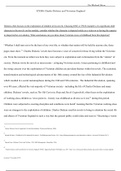Dr Michael Shaw
EN580: Charles Dickens and Victorian England
Dickens often focuses on the exploitation of children in his novels. Choosing ONE or TWO example/s of a significant child
character in the novel/s on this module, consider whether this character is depicted solely as a victim or as having the capacity
to shape his/her own destiny. What conclusions can you draw about Victorian views of childhood from this depiction?
“Whether I shall turn out to be the hero of my own life, or whether that station will be held by anyone else, these
pages must show.”1 Charles Dickens’ novels have become a voice of concern for those living within the Victorian
era. From the moment an infant was born they were subject to exploitation and victimisation from the “station” of
society. Dickens wrote his novels as microcosms - critiquing Victorian society. Issues pertaining to childhood and
the rising concern over the exploitation of Victorian children are prevalent themes within his novels. The economic
transformation and technological advancements of the 18th century created the rise of the Industrial Revolution
which resulted in a social metamorphosis during the 18th and 19th centuries. The Industrial Revolution, spanning
over 80 years, affected the vast majority of Victorian society - including the life of Charles Dickens and many
children. Dickens’ novels, such as The Old Curiosity Shop and David Copperfield, often focus on the exploitation
of working-class children as “at no point in…history was childhood as diverse as it was”2 during this period.
Children were subjected to exacting discipline and conditions were harsh3 meaning that the Victorian working-class
were no strangers to the exploitation of children. Charles Dickens used his novels to bring to attention the social ills
and abuses of Victorian England in such a way that the general public could relate and react to.4 Becoming a victim
1
Charles Dickens, David Copperfield, 3rd edn (Hertfordshire: Wordsworth Editions, 2000).
2
Hannah Wichner, "Childhood In The Industrial Revolution", The Bildungsroman Project, 2013 <http://bildungsromanproject.com/industrial-revolution/> [accessed 28 October 2017].
3
Pamela Horn, Children's Work And Welfare, 1780-1880S (Basingstoke: Macmillan, 1994).
4
"Charles Dickens And Social Reform In Victorian England", RNIB - Supporting People With Sight Loss, 2017 <http://www.rnib.org.uk/charles-dickens-and-social-reform-victorian-england>
[accessed 7 November 2017].
, Dr Michael Shaw
EN580: Charles Dickens and Victorian England
of society was inevitable during this time period; with this in mind, focusing on two of Dickens’ novels; The Old
Curiosity Shop (1841)5 and David Copperfield(1850),6 this essay will argue that the childhoods of Victorian
working-class children were terminated prematurely and that Dickens’ portrayal of children depicted them as solely
victims of society.
The economy was a constant concern in the Victorian era - the “1830s and 1840s …[were] marked by
unemployment, poverty, rioting, [and] slums in large cities.”6 This meant that the working conditions were poor, the
treatment of people was terrible and many were left in debt. Charles Dickens, himself, witnessed the full effect of
this economic disaster after his father was imprisoned in 18247 for debt. Dickens was born into a working class
family who often enjoyed entertainment8 however when his father was imprisoned, Dickens was sent to work in a
blacking factory at the tender age of 12. “This experience of lonely hardship was the most significant event of his
life.”9 The experience of a “lonely hardship” was not unusual due to the exploitation and expectations of children - a
good example of this is the child protagonist Nell Trent in The Old Curiosity Shop whose grandfather’s gambling
addiction leaves them in debt. Due to the poor conditions of this time, children were expected to enter into
premature responsibilities and care for their family. This expectation is what allowed many incidents to go
unnoticed to the public eye therefore making children victims of the society into which they were born. The
5
Charles Dickens, The Old Curiosity Shop, 2nd edn (Hertfordshire: Wordsworth Editions Limited, 2001)
6
Charles Dickens, David Copperfield, 3rd edn (Hertfordshire: Wordsworth Editions, 2000).
6
Vaijayanti Joshi, "Victorian Era Economy", Victorian-Era.Org, 2017 <http://www.victorian-era.org/victorian-era-economy.html> [accessed 3 November 2017].
7
William F. Long, "Two Letters Of John Dickens From 1835", Dickens Quarterly, 33.4 (2016), 291-299 <https://doi.org/10.1353/dqt.2016.0037>.
8
"The Childhood Of Charles Dickens | Charles Dickens Info", Charlesdickensinfo.Com, 2017 <https://www.charlesdickensinfo.com/life/childhood/> [accessed 5 November 2017].





